
Beewolfbiology
Biology of the European beewolf (Philanthus triangulum, Hymenoptera, Crabronidae)
The European beewolf is a solitary digger wasp of the genus Philanthus that comprises about 140 species worldwide. Female beewolves construct nest burrows in sandy soil, hunt honeybees (Apis mellifera), paralyze them by stinging and carry the prey to the nest in flight. One to five honeybees are provisioned as larval food in each brood cell. The larva feeds on the prey and spins a cocoon that is attached with its basal part to the wall of the brood cell. Larvae mostly overwinter and emerge next summer.
Since the conditions in the brood cell are humid and warm, there is a continuous threat that pathogenic microorganisms, in particular mold fungi, infest the larva or the provisioned honeybees, which usually results in the death of the larva. Therefore, there is a high selection pressure on female beewolves to protect their offspring against pathogens, and beewolves evolved at least two different ways to reduce offspring mortality in the brood cell:
(1) They apply large amounts of a secretion from a cephalic gland to the provisioned honeybees, which significantly delays fungal growth on the bees.
(2) The beewolf female secretes a whitish subtance from its specialized antennal glands to the brood cell that contains symbiotic bacteria of the genus Streptomyces. The bacteria are later taken up by the larva and applied to its cocoon, where they significantly reduce fungal infestation and thereby protect the larva.
(3) Beewolf eggs emit gaseous nitric oxide (NO) to fumigate their brood cell. NO is spontaneously oxidized to NO2 with the latter causing a pungent smell of the brood cells. Both are radicals and more or less toxic. As a consequence, most fungi in the brood cell are killed. Thus the paralyzed bees can be consumed by the larva without competition by mold fungi. However, it is a puzzle how the eggs themselves but also the symbiotic Streptoymces bacteria can survive the toxic atmosphere in the brood cell.
Male beewolves establish territories consisting of about 0.25 m2 of vegetation, mostly in the vicinity of the females’ nest aggregations. They mark their territories with a pheromone from cephalic glands and defend them against intruding males in combat flights without physical contact of the opponents. Territories of different males are often found close together, thereby constituting a lek situation in which the females have an ideal opportunity to choose among males. Since the copulation is not preceded by any kind of visual display, female choice could, at least predominately, be based on information obtained from the male sex pheromone.
|
|
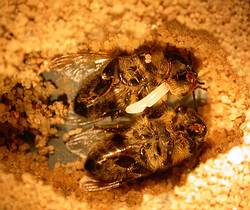
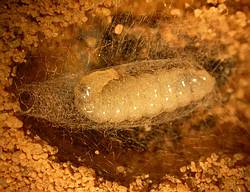
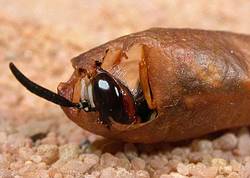
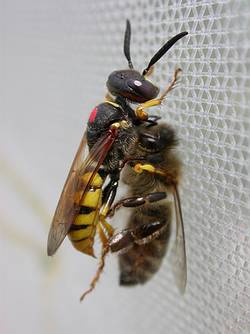
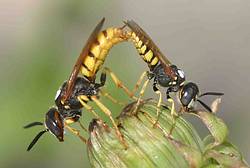
Fotos © Martin Kaltenpoth
Publications
Strohm E, Herzner G, Ruther J, Kaltenpoth M, Engl T (2019 in press) eLife 2019;8:e43718. Nitric oxide radicals are emitted by wasp eggs to kill mold fungi. DOI: https://doi.org/10.7554/eLife.43718.
Kaltenpoth M, Kroiss J, Strohm E (2007) The odor of origin: kinship and geographical distance are reflected in the marking pheromone of male beewolves (Philanthus triangulum F., Hymenoptera, Crabronidae). BMC Ecology 7:11.
Herzner G, Schmitt T, Peschke K, Hilpert A, Strohm E (2007). Food wrapping with the post pharyngeal gland secretion by females of the european beewolf Philanthus triangulum. Journal of Chemical Ecology 33 (4): 849-859.
Herzner G, Goettler W, Kroiss J, Purea A, Webb A, Jakob PM., Rössler W, Strohm E (2007). Males of a solitary wasp possess a postpharyngeal gland. Arthropod Structure & Development 36: 123-133.
Strohm E, Herzner G, Goettler W (2007). A "social" gland in a solitary wasp? The postpharyngeal gland of female European beewolves (Hymenoptera, Crabronidae). Arthropod Structure & Development 36: 113-122.
Herzner G, Strohm E (2007). Fighting fungi with physics: food wrapping by a solitary wasp prevents water condensation. Current Biology 17: R46-R47.
Goettler, W., Kaltenpoth, M., Herzner, G., Strohm, E. (2007) Morphology and ultrastructure of a bacteria cultivation organ: The antennal glands of female European beewolves, Philanthus triangulum (Hymenoptera, Crabronidae). Arthropod Structure & Development 36: 1-9.
Kroiss J, Schmitt T, Schreier P, Strohm E, Herzner G (2006). A selfish function of a social gland? A postpharyngeal gland functions as sex pheromone reservoir in males of a solitary wasp. Journal of Chemical Ecology 32: 2763-2776.
Kaltenpoth, M. (2006) Symbiotische Streptomyces-Bakterien in Grabwespen. Naturwissenschaftliche Rundschau 59 (11): 618-619.
Kaltenpoth, M., Strohm, E. (2006). The scent of senescence: Age-dependent changes in the composition of the marking pheromone of the male European beewolf (Philanthus triangulum, Hymenoptera, Crabronidae). Journal of Insect Science 6:20.
Herzner, G., Schmitt, T., Heckel, F., Schreier, P. and Strohm, E. (2006). Brothers smell similar: Variation in the sex pherome of male European Beewolves and its implications for inbreeding avoidance. Biological Journal of the Linnean Society. 89: 433-442.
Kaltenpoth, M., Göttler, W., Dale, C., Stubblefield, J.W., Herzner, G., Roeser-Mueller, K., and Strohm, E. (2006) 'Candidatus Streptomyces philanthi', an endosymbiotic streptomycete in the antennae of Philanthus digger wasps. International Journal of Systematic and Evolutionary Microbiology 56 (6): 1403-1411.
Herzner, G., Schmitt, T., Linsenmair, K. E. and Strohm, E. (2005). Prey recognition by females of the European beewolf and its potential for a sensory trap. Animal Behaviour 70, 1411-1418.
Kaltenpoth, M. (2005). Bakterien schützen Wespen-Nachwuchs vor Pilzbefall. Naturwissenschaftliche Rundschau 58: 329-330.
Kaltenpoth, M., Göttler, W., Herzner, G. and Strohm, E. (2005). Symbiotic bacteria protect wasp larvae from fungal infestation. Current Biology 15: 475-479.
Kaltenpoth, M., Strohm, E. and Gadau, J. (2004). Polymorphic microsatellite markers for a solitary digger wasp, the European beewolf (Philanthus triangulum; Hymenoptera, Sphecidae). Molecular Ecology Notes 4: 589-592.
Strohm, E. and Daniels, W. (2003). Ultrastructure meets reproductive success: performance of a sphecid wasp is correlated with the fine structure of the flight-muscle mitochondria, Proc. R. Soc. Lond. Ser. B-Biol. Sci. 270, 749-754.
Schmitt, T., Strohm, E., Herzner, G., Bicchi, C., Krammer, G., Heckel, F. and Schreier, P. (2003). (S)-2,3-dihydrofarnesoic acid, a new component in cephalic glands of male european beewolves Philanthus triangulum, J. Chem. Ecol. 29, 2469-2479.
Herzner, G., Schmitt, T., Linsenmair, K. E. and Strohm, E. (2003). Flagellar sensilla in male and female European beewolves, Philanthus triangulum F. (Hymenoptera : Sphecidae), Entomol. Fenn. 14, 237-247.
Strohm, E. and Marliani, A. (2002). The cost of parental care: Prey hunting in a digger wasp, Behavioral Ecology 13, 52-58.
Strohm, E., Schmitt, T., Herzner, G. and Schreier, P. (2002a). Wolves in sheep's fur? Chemical camouflage in the European beewolf and its major brood parasitoid, Zoology Jena 105, 30.
Strohm, E. and Linsenmair, K. E. (2001). Females of the European beewolf preserve their honeybee prey against competing fungi, Ecological Entomology 26, 198-203.
Strohm, E. (2001). Females of the European beewolf preserve their larval provisions against competing fungi, Zoology Jena 103, 52.
Strohm, E., Laurien, K. C. and Bordon, S. (2001). Escape from parasitism: Spatial and temporal strategies of a sphecid wasp against a specialised cuckoo wasp, Oecologia Berlin 129, 50-57.
Strohm, E. and Lechner, K. (2000). Male size does not affect territorial behaviour and life history traits in a sphecid wasp, Animal Behaviour 59, 183-191.
Strohm, E. and Linsenmair, K. E. (2000). Allocation of parental investment among individual offspring in the European beewolf Philanthus triangulum F. (Hymenoptera: Sphecidae), Biological Journal of the Linnean Society 69, 173-192.
Strohm, E. (2000). Factors affecting body size and fat content in a digger wasp, Oecologia Berlin 123, 184-191.
Strohm, E. and Linsenmair, K. E. (1999). Measurement of parental investment and sex allocation in the European beewolf Philanthus triangulum F. (Hymenoptera: Sphecidae), Behavioral Ecology and Sociobiology 47, 76-88.
Strohm, E. and Linsenmair, K. E. (1998). Temperature dependence of provisioning behaviour and investment allocation in the European beewolf Philanthus triangulum F, Ecological Entomology 23, 330-339.
Strohm, E. and Linsenmair, K. E. (1997). Low resource availability causes extremely male-biased investment ratios in the European beewolf, Philanthus triangulum F. (Hymenoptera, Sphecidae), Proceedings of the Royal Society of London Series B Biological Sciences 264, 423-429.
Strohm, E. and Linsemair, K. E. (1997). Female size affects provisioning and sex allocation in a digger wasp, Animal Behaviour 54, 23-34.
Strohm, E. (1995). Allokation elterlicher Investitionen beim Europäischen Bienenwolf Philanthus triangulum Fabricius (Hymenoptera: Sphecidae). Berlin: Verlag Dr. Köster.
Strohm, E. and Linsenmair, K. E. (1994/95). Leaving the cradle: How beewolves (Philanthus triangulum F.) obtain the necessary spatial information for emergence, Zoology Jena 98, 137-146.
